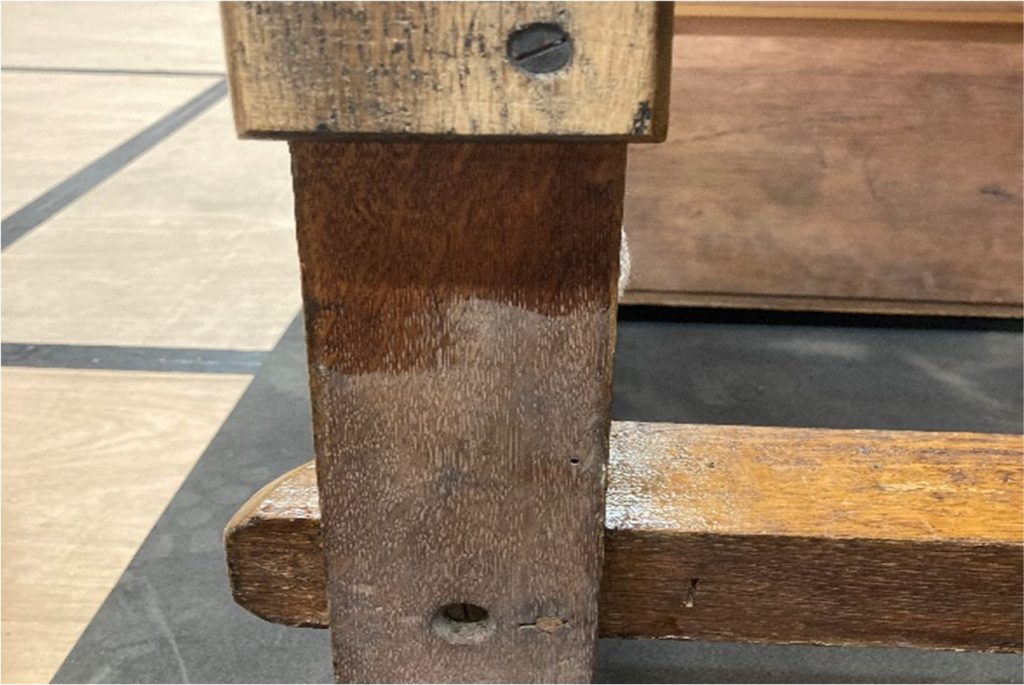Katarina Kunova gets busy cleaning Victorian Neo-Gothic furniture for the 40-hour work placement as part of the Applied Humanities: Employability in Practice Module. The module aims to introduce Humanities students to a range of work-related skills such as communication, teamwork, problem-solving, decision-making, initiative, and creativity, thus improving their employability.
Conservation in Action, by Katarina Kunova, English Literature student
For the first time in my life, I was able to physically touch a relic that resembled something straight out of a museum, instead of merely looking at a glass cabinet or reading an information label… and it was a big responsibility.
I’d volunteered to be a Conservation Volunteer at Dover’s historic Maison Dieu, and after introductory training on cleaning techniques from Louise Davison (Conservation Intern with Bainbridge Conservation) was being let loose on a Victorian desk from the council chamber.
For those who don’t know it, this fascinating building in the heart of Dover was originally built in about 1200 as a medieval pilgrim hospital, giving poor pilgrims on their way to visit the shrine of St Thomas Becket at Canterbury Cathedral free bed and board for the night.
It’s since been a victualling office (making ship’s biscuit and beer for the Royal Navy), town hall, prison and popular events venue. The building is currently the subject of the Heritage Lottery funded Reawakening the Maison Dieu project, which will conserve the building, add in new facilities and make it accessible to people with disabilities.
Part of the action-packed programme of free activities is Conservation in Action, which runs throughout 2022 and gives visitors the opportunity to see conservators at work, cleaning and conserving the building’s impressive collection of historic oil paintings, regimental colours and Victorian furniture, including by renowned Neo-Gothic architect and designer William Burges.
Visitors can also chat to them about what they are doing, listen to talks, and have a go at activities such as gilding using real gold leaf.
I was working with other volunteers in a pop-up Conservation Studio in the building’s magnificent medieval Stone Hall. What did surprise me was that each volunteer was assigned a table to take care of by themselves.
I’m the type who worries about not following instructions precisely… and ruining some historical artefact, but I quickly realized my concerns were unfounded as the conservators were quick to set my mind at ease and were both helpful and accommodating. We each got a table to clean – very slowlyand gently – using a cotton swab and distilled water. It might sound tedious, but believe me, it surprisingly turned into a meditation.
Sometimes we were quiet and focused on the task. At other times we chatted or listened to the radio as we worked, steadily and methodically. It felt immensely satisfying to see the dusty, dirt-engrained table transformed over a period of just a few hours, with water and gentle swabbing.
My work placement’s now over… but I enjoyed it so much, I’m staying on as a volunteer. As well as helping with the conservation programme, I’m looking forward to assisting with future events, including, as a big Gothic fan, some spooky Halloween tours planned for the Victorian jail this autumn!

 Faculty of Arts, Humanities and Education
Faculty of Arts, Humanities and Education Laura Krutnik
Laura Krutnik 775
775


